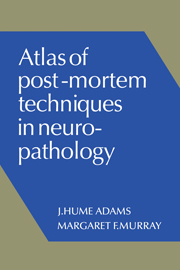Preface
Published online by Cambridge University Press: 21 May 2010
Summary
As every neuropathologist knows, the brain and spinal cord are often not removed as well as they should be post mortem: it is very frustrating to be asked to undertake a neuropathological assessment on specimens that are so distorted that it is difficult, if not impossible, to reconstitute the situation that existed prior to death. Yet this is precisely the information sought by neurosurgeon, neurologist and neuroradiologist. Since it is not difficult to remove the brain and cord properly, one can only assume that pathologists and mortuary attendants are unaware of the importance of doing so. A common reason for a brain becoming distorted is that it is removed by the mortuary attendant and then left lying on the dissecting bench for some time before the pathologist decides that it should be fixed intact for dissection later. Furthermore, the optic chiasma and the brain stem are often torn, and the lower medulla and the vertebral arteries are often left within the skull. These observations are not meant to be critical of mortuary attendants, but more of pathologists who fail to appreciate the importance of removing the brain themselves, or at least being present when it is being removed.
Information
- Type
- Chapter
- Information
- Atlas of Post-Mortem Techniques in Neuropathology , pp. ix - xiiPublisher: Cambridge University PressPrint publication year: 1982
